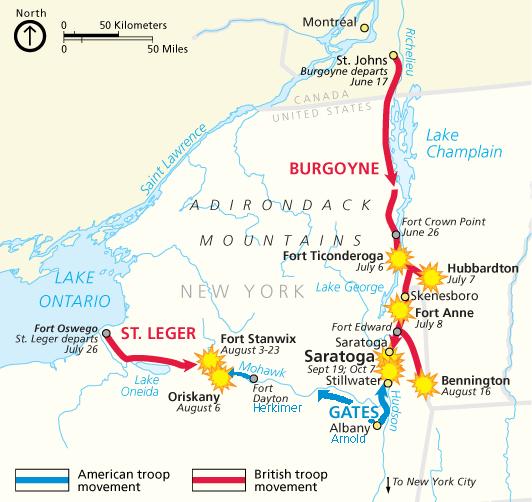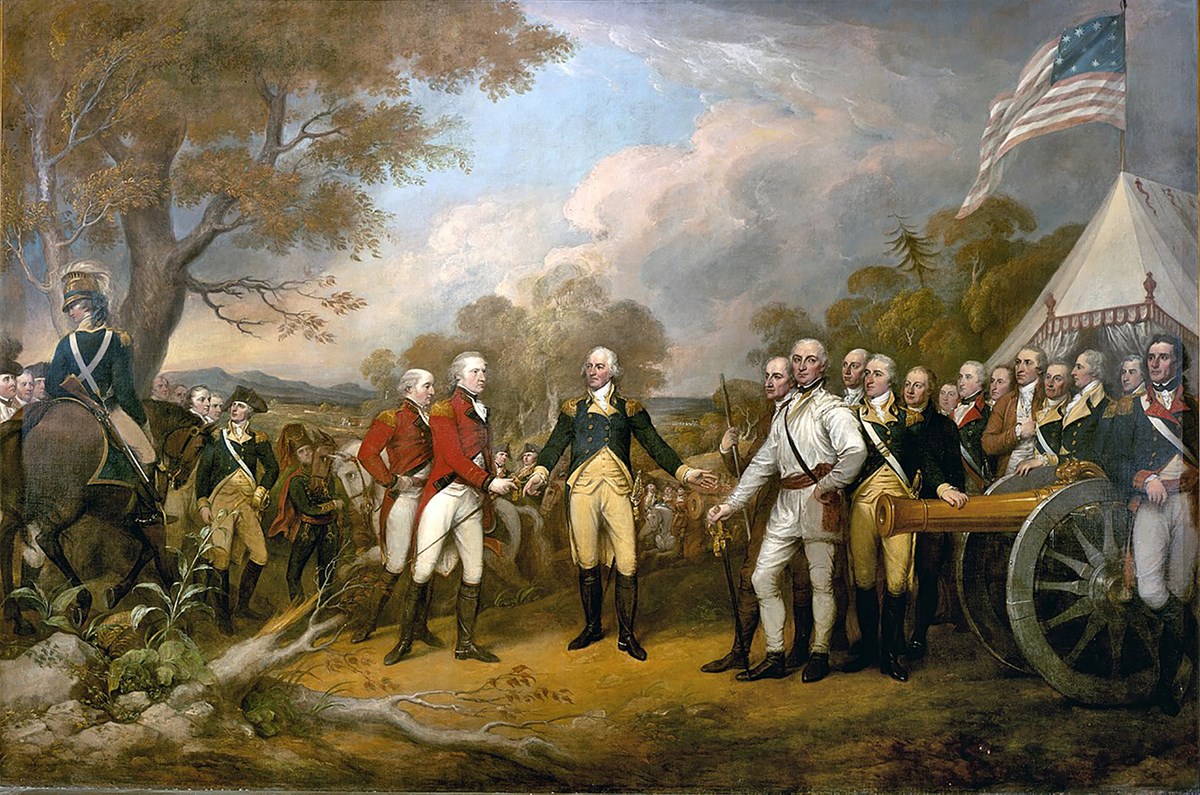
From the beginning of the American Revolution, the British had understood the importance of gaining control of the Lake Champlain-Lake George-Hudson River water route to effectively cut off the colonies north of New York from those to the south. Almost all the troubles leading to the war had originated from New England, and the British hoped that if they could put down the rebellion there, the rest of the colonies might consider abandoning the war. British dominance of New York would also make it difficult or impossible for the Americans to move troops and supplies between the northern and southern colonies. The British made their first attempt to seize this waterway in 1776. The British army under Gen. Sir William Howe was successful in taking New York City and some of the lower Hudson Valley area during the summer. The force moving south from Canada under Canadian Governor Gen. Sir Guy Carleton was stalled in October at Ft. Ticonderoga, however, due to the extensive and well garrisoned American defensive positions around the fort. Not wanting to engage in siege operations with winter coming on, the British retreated back into Canada. In early 1777 Gen. John Burgoyne, who had been with the British force coming from Canada in '76, proposed the plan be tried again, this time with him in command.
Burgoyne's plan called for him to lead a large force south from Canada and drive for Albany. Once in Albany, he would open lines of communication between Albany and New York City. Gen. William Howe (Commander in Chief of all British forces in America) had already had his plan to take Philadelphia approved by the ministry, but he was also expected to be able to support Burgoyne’s operations if necessary. In the end however, nobody involved on the British side (including Burgoyne) felt that much additional help would be necessary. It would not be until after his defeat that Burgoyne put more emphasis on Howe’s failure to support him more fully. Burgoyne had first proposed the idea of a Mohawk Valley expedition to Canadian Governor Carleton in the summer of 1776, as Carleton prepared for his own push down Lake Champlain. Burgoyne had been desperate for an independent command and had met with both Superintendent of Indian Affairs Guy Johnson and Mohawk Valley Baronet Sir John Johnson. On gaining their assurances of the widespread Indian and Loyalist support to be had in the valley, Burgoyne pushed for the plan to be carried out, with himself in command. While initially receptive to the idea, Carleton was also wary of bringing the Indians into the conflict too early and ultimately cancelled the expedition. In 1777, Burgoyne still saw the merit of an expedition into the Mohawk Valley, but now that he had command of the main army, he decided to drastically cut back the size of the forces committed to it. In the end a smaller British Force under Lt. Col. Barry St. Leger, light in artillery and British troops and heavy in Indians and Loyalists, was to move westward from Canada down the Mohawk Valley and join Burgoyne at Albany. In addition to acting as a diversion, St. Leger's force would recruit Loyalists in the valley and secure the western water route between Canada and New York City.
The British campaign got off to a promising start. The Americans abandoned Ft. Ticonderoga without firing a shot and by the beginning of August, Burgoyne was advancing steadily towards Albany and encountering little resistance. At the same time, St. Leger began his siege of Ft. Schuyler. By the end of the month, however, things changed drastically for the British. St. Leger's siege against the fort was broken and his troops were forced to retreat back to Canada.
Meanwhile, Burgoyne, had sent a detachment of German troops from his army to seize supplies at Bennington, Vermont. On August 16, the Germans were attacked by New England militia under Gen. John Stark near the New York/Vermont border and most of the detachment was killed, wounded, or captured. A second detachment of Germans was badly mauled and forced to retreat. Both these engagements were lumped together in history to become the Battle of Bennington.
Despite these setbacks, Burgoyne decided to push on to Albany. He was within 50 miles of Albany when American forces under Gen. Horatio Gates halted his advance. The Americans had fortified the heights near Stillwater to block British access to the Hudson River. Scouting parties were then sent out to locate Burgoyne's army. On September 19th, American forces collided with part of Burgoyne's army in the fields and woods surrounding the farm of a local Tory known as Freeman. The fighting seesawed back and forth across Freeman's Farm as one side would gain ground only to be forced from it a short time later. Both sides, recorded one American participant, "…Seemed determined to conquer or die.." The battle was finally ended by the timely arrival of a German contingent from Burgoyne's army, and the approach of night. The Americans then retreated back inside their lines. This ended the first battle of Saratoga (also known as the Battle of Freeman's Farm).
Though Burgoyne claimed a victory, the battle had cost him around 600 casualties, winter was approaching, and he was running short on supplies. Rather than renew his offensive immediately however, Burgoyne decided to hold fast and fortify his position. He had received word that Howe's second in command, Gen. Sir Henry Clinton, was making a push up the Hudson from New York City in an attempt to draw some of the American pressure off of Burgoyne's army. Burgoyne decided to wait until Clinton was nearby to renew his advance. Gen. Clinton however did not begin his advance until October 3rd, and by that time, Burgoyne's situation was critical. His supplies were almost gone, and his foraging parties and sentry posts were continuously harassed by American troops and their Oneida Indian allies. Burgoyne decided to make one last attempt to reach Albany.
On October 7th, Burgoyne sent out a large detachment of his army to scout out the American's defensive line, and to gather forage from the wheat field of the nearby Barber Farm. While his troops were thus engaged, they came under a vigorous attack from a detachment of Gate's army. Burgoyne's troops were pushed back all along their lines and were soon in full retreat back to their fortified positions. The redoubt on the left of the British line proved too difficult for the Americans to take, so they turned their attention to the one on the right, held by some of Burgoyne's German troops. Attacked from all sides, the Germans were soon routed, and the redoubt was taken. Though Burgoyne's lines were now open in the side and rear, the American forces were scattered, and night was coming on. The Americans pulled back to regroup and this ended the second battle of Saratoga (also known as the Battle of Bemis Heights).
Burgoyne finally accepted the fact that he would not be able to reach Albany and began a slow retreat back towards Canada, harassed by Gates’ army the whole time. Halting briefly at the village of Saratoga, Burgoyne's army was soon surrounded. Wishing to spare his troops any further needless hardship or bloodshed, Burgoyne proposed to surrender his army to Gates. Burgoyne was given very generous terms of surrender by Gates, who was worried about Gen. Clinton's actions on the Hudson River. Clinton, for his part, had advanced steadily up the Hudson, taking the American Forts Clinton and Montgomery. He then sent a detachment further up which burned the American capital of New York, Esopus (present day Kingston), and worked its way within 40 miles of Albany. By this time, however, Gen. Howe was calling for reinforcements for his troops in Philadelphia, and rumors of Burgoyne’s situation reached Clinton’s forces. At this point, he decided to end his operations on the Hudson and return to New York City. This would be the one and only time the British controlled the Hudson River.
Burgoyne, who had been stalling surrender negotiations hoping that Clinton would save him, now finally accepted his fate. As a face-saving demand and point of honor however, Burgoyne would not allow the term “surrender” to be used however and insisted on calling it a “Convention.” On October 17th, some 6,000 British and German troops formally surrendered to Gates’ army near Saratoga. The initial surrender terms had allowed for these troops to return to England, on the condition they would never serve again in America. Congress would not agree to this provision however, and Burgoyne's army instead became prisoners of war.
The outcome of many important military campaigns throughout history was a result of individual events throughout. The 1777 Campaign on New York was no different, with the American victory at Fort Stanwix/Schuyler playing a major role in what would happen later that year. In turn, while the American victory at Saratoga ended Britain's attempts to split the colonies by invading from Canada, it had many more far-reaching consequences. Chief of those was helping to bring about a formal alliance between the United States and France in 1778. This alliance would not only enable the Americans to continue their fight for independence; it would also turn a colonial rebellion into a world war.

